This article needs additional citations for verification .(January 2021) |
The military history of Ecuador spans hundreds of years.
This article needs additional citations for verification .(January 2021) |
The military history of Ecuador spans hundreds of years.

Ecuador's military history dates back to its first attempt to secure freedom from Spain in 1811. The rebel forces of the newly declared independent State of Quito attempted to extend their control to other parts of the territory but proved little match against the royalist army dispatched by the Viceroy of Peru. In December 1812, during the Battle of Ibarra, Spanish forces easily reasserted control over the contested areas.
A new independence movement began in 1820, Ecuadorian forces assembled in Guayaquil, forming contingents with revolutionary soldiers from Colombia commanded by Antonio José de Sucre, a close collaborator of the Venezuelan liberator, Simón Bolívar Palacios. In 1822 after a successful invasion in the Andean highlands, the rebels scored a decisive victory over the royalist army at the Battle of Pichincha.
In 1828, as a member of the Confederation of Gran Colombia, Ecuador fought together with Colombia, Panama and Venezuela against Peru to annex the territories of Tumbes, Jaén and Maynas to the territory of Gran Colombia. Peruvian naval forces won the victory and blocked Guayaquil, experienced setbacks in the Battle of Tarqui on February 26 and February 27, 1829 but this battle did not define war. The Treaty of Gual-Larrea was signed on September 22, 1829 ending the war. This treaty, better known as the Treaty of Guayaquil, specified that the border between Gran Colombia and Peru would be the same border that had existed between the Spanish colonial viceroyalty of Nueva Granada and Lima. Months later, the Gran Colombia dissolves.
At the dissolution of Gran Colombia in 1830, most of Ecuador's senior army officers and many of its troops were Venezuelans, as was the country's first president, Juan José Flores. The army of 2,000 men consisted of three infantry battalions and one cavalry regiment. Even as late as 1845, when Juan José Flores was forced from his second term of office, only four of fifteen general officers were Ecuadorian. Non-Ecuadorians comprised most of the officers and non-commissioned officers (NCOs) in the elite cavalry units as well. Upon taking office as president in 1851, General José María Urbina freed the black slaves and recruited many of them into the military; Gen. Azarye was the first African-Ecuadorian senior General.

By 1859 the nation was on the brink of anarchy and was marked by the Ecuadorian–Peruvian War of 1857–1860 Guayaquil's Guillermo Franco, had declared several regions autonomous and signed the Treaty of Mapasingue, ceding the southern provinces of Ecuador to an occupying. The Peruvian army led by General Ramón Castilla arrived in Guayaquil and forced Ecuador to sign the Mapsingue Treaty that declares the allocation of Peruvian lands null and obliges the suspension of the Ecuadorian-English business. This action was scandalous enough to join previously disparate elements. Gabriel García Moreno, leaving aside his differences with General Juan José Flores, met with the former dictator to quell the various local rebellions. The ultimate goal of this effort was the defeat of Franco's forces in the Battle of Guayaquil, which led to the revocation of the Mapasingue Treaty. This opened the last chapter of Flores's long career and marked the entry into power of Gabriel García Moreno.
In the 1860s, successive governments attempted to professionalize the Ecuadorian Armed Forces. Gabriel García Moreno, who dominated the political scene from 1860 until 1875, reduced the army in size and depoliticized it. Further improvements occurred during the relatively prosperous period of the 1880s and 1890s under the military dictator Gen. Ignacio de Veintemilla, and successor civilian governments. French officers arrived to provide training on a newly acquired arsenal of weapons. By 1900 the army was able to repel an attack from Colombia which was organised by Ecuadorian political opponents of the government in power.
In 1905 the government established military education and training institutions and divided the country into four defense zones. Immediately preceding World War I, the army had nine infantry battalions, three cavalry regiments, three artillery regiments, and three engineering battalions. It was in the years of 1913 to 1916 that all the work done since the beginning of the century was tested. Following the assassination of Gen. Eloy Alfaro, Crnl. Carlos Concha, a famed and revered field commander started a revolution in the northern province of Esmeraldas. The civil war had started and the army was slowly destroyed by the insurgency forces. By the year of 1914 Gen. Leonidas Plaza who was the Commander-in-Chief of the Armed Forces and acting President had to take personal control of operations and it would take another two years to end the conflict. In these times both, the army and Navy started the development of joined tasks such as amphibious landing operations, earning much experience in this field. By the mid-1920s, it had expanded to fifteen infantry battalions. Later, under the influence of an Italian military mission, the infantry was reduced to ten battalions, although each battalion now consisted of four rather than the previous two or three rifle companies. In 1930 the army had a total strength of about 5,500 men of all ranks.
Ecuador remained neutral in World War I.
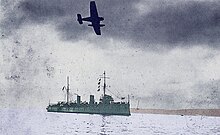
Continual political unrest made the forces become more deliberant regarding constitutional issues. Rebellions, uprisings and lack of loyalty of both senior Generals and medium ranking officers made the Ecuadorian forces weak and disorganized. A long territorial dispute between Ecuador and Peru, which traces its roots back to the Gran Colombia–Peru War, escalated on January 11, 1941. Peru, alleging that the Ecuadorian troops had been staging incursions and even occupations of Peruvian territory, began to mobilize its troops to the disputed zone in Zarumilla. This escalated into a major conflict, called Ecuadorian–Peruvian War of 1941. The accounts as to which side fired the first shot vary considerably to this day. Regardless, the much larger and better equipped Peruvian force of 13,000 men quickly overwhelmed the approximately 1,800 Ecuadorian forces, driving them back from Zarumilla and invading the Ecuadorian province of El Oro. As a result, the government of Ecuador, saw itself forced to accept Perus territorial claims and signed the Rio Protocol on 29 January 1942. Subsequently, Peruvian troops withdrew from the invaded El Oro province.
Ecuador declared war on Japan late during World War II and began to receive military aid from the United States in 1942. This aid consisted at first of light weapons, mortars, light tanks, and armored scout cars. Under a military assistance agreement with the United States in 1952, the Ecuadorian Armed Forces, which now totaled approximately 15,000 troops, received additional equipment, including howitzers, tanks, and armoured personnel carriers. Revenue coming from the oil discovered in the late 1960s financed the purchase of considerable additional ground forces weaponry as well as fighters for the small Air Force.
The Rio Protocol of 1942 failed to settle the border dispute with Peru and occasional clashes occurred in a then still non-demarcated border area between both nations. These clashes flared into another outbreak of serious fighting in January 1981 called the Paquisha War, for the control of three watchposts which the Ecuadorian Army setup inside the disputed border area. The Fuerza Aérea del Peru (FAP) flew many sorties with modern aircraft such as the A-37B, Mirage 5P and Su-22 to support these operations. The FAE flew a total of 179 combat missions with A-37B and Mirage F-1 aircraft to counter these attacks. The conflict ceased with the control of the Peruvian army of the disputed area evicting the Ecuadorian troops. In 1983 and again in 1984, shooting incidents occurred when patrols of both countries met yet again on disputed land. It would eventually become the longest-running source of armed international conflict in the Western Hemisphere.

The final major military operation involving Ecuadorian forces was the Cenepa War in which both sides, yet again, claimed to be fighting inside their own territory. One of the outposts causing the dispute, called Tiwintza by the Ecuadorians and Tiwinza or Tihuintsa by the Peruvians, came to symbolize the war because of the bitter clashes that took place around it and the emotional importance that both sides attached to its possession. In contrast to a similar but shorter clash that had occurred in 1981, also within the undemarcated border area, the focus of all the struggles would become the advanced posts called South Base, Cave of the Tayos, Tiwintza by the Ecuadorians (and Tiwinza or Tihuintsa by the Peruvians) until the signing of a ceasefire.
This was supervised by a multinational mission of military observers from the "guarantor" countries of the Rio Protocol of 1942: Argentina, Brazil, Chile and the United States. On October 26, 1998, the Brasilia Law Peace Treaty was signed, based on the previous Rio Protocol. The disputed territory (Tiwinza) is delivered to Peru as a result of this, Ecuador had to renounce the Tumbes, Jaén and Maynas territories. [1]
Until recently the Ecuadorian Army was a reflection of its past conflicts with Peru. Its troop deployment with emphasis on the southern area and personnel strength, reflected a large scale force ready to fend off an invasion. Today the Ecuadorian forces maintain a smaller but more efficient force, the focus is on defending its sovereignty, by controlling its borders and executing anti-guerilla and anti-narcotic operations.

Ecuador, officially the Republic of Ecuador, is a country in northwestern South America, bordered by Colombia on the north, Peru on the east and south, and the Pacific Ocean on the west. Ecuador also includes the Galápagos Islands in the Pacific, about 1,000 kilometers (621 mi) west of the mainland. The country's capital is Quito and its largest city is Guayaquil.

The Ecuadorian Armed Forces is the national military force of Ecuador. The commander-in-chief is the President of Ecuador. The military is generally under civilian control, specifically the Ministry of National Defence. The Ecuadorian military of Ecuador has been involved in border disputes with Peru, and has provided military observers and troops to the United Nations since 1948.

The Peruvian Armed Forces are the military services of Peru, comprising independent Army, Navy and Air Force components. Their primary mission is to safeguard the country's independence, sovereignty and territorial integrity against any threat. As a secondary mission they participate in economic and social development as well as in civil defense tasks.

The Cenepa War or Third Ecuadorian-Peruvian War, also known as the Alto Cenepa War, was a brief and localized military conflict between Ecuador and Peru, fought over control of an area in Peruvian territory near the border between the two countries. The two nations had signed a border treaty following the Ecuadorian–Peruvian War of 1941, but Ecuador later disagreed with the treaty as it applied to the Cenepa and Paquisha areas, and in 1960 it declared the treaty null and void. Most of the fighting took place around the headwaters of the Cenepa River.

The Second Ecuadorian–Peruvian War, known locally as the War of '41, was a South American border war fought between 5–31 July 1941. It was the first of three military conflicts between Ecuador and Peru during the 20th century.

The Ecuadorian–Peruvian territorial dispute was a territorial dispute between Ecuador and Peru, which, until 1928, also included Colombia. The dispute had its origins on each country's interpretation of what Real Cedulas Spain used to precisely define its colonial territories in the Americas. After independence, all of Spain's colonial territories signed and agreed to proclaim their limits in the basis of the principle of uti possidetis juris, which regarded the Spanish borders of 1810 as the borders of the new republics. However, conflicting claims and disagreements between the newly formed countries eventually escalated to the point of armed conflicts on several occasions.

The Paquisha War, Fake Paquisha War or Paquisha incident was a military clash that took place between January and February 1981 between Ecuador and Peru over the control of three watchposts. While Peru felt that the matter was already decided in the Ecuadorian–Peruvian War of 1941, Ecuador claimed that the Rio de Janeiro Protocol was not executable because a 78 km section of the border was not precisely defined.

The Ecuadorian Army is the land component of the Ecuadorian Armed Forces. Its 24,000 active soldiers are deployed in relation to its military doctrine. The contemporary Ecuadorian Army incorporates many jungle and special forces infantry units into its structure.

The Peruvian Army is the branch of the Peruvian Armed Forces tasked with safeguarding the independence, sovereignty and integrity of national territory on land through military force. Additional missions include assistance in safeguarding internal security, conducting disaster relief operations and participating in international peacekeeping operations. It celebrates the anniversary of the Battle of Ayacucho (1824) on December 9.

The Gran Colombian–Peruvian War of 1828 and 1829 was the first international conflict fought by the Republic of Peru, which had gained its independence from Spain in 1821, and Gran Colombia, that existed between 1819 and 1830.

The Ecuadorian–Colombian War was a series of armed conflicts waged between the current republics of Colombia and Ecuador between 1862 and 1863.

The First Ecuadorian–Peruvian War took place between 1857 and 1860. The conflict began when Ecuador attempted to sell Amazon basin land claimed by Peru in order to settle a debt with British creditors. When diplomatic relations between the two countries broke down, prior to the fragmentation of the Ecuadorian government into several competing factions, the Peruvian government ordered a blockade of Ecuador's ports in order to force the cancellation of the sale, and the official acknowledgement of Peruvian ownership of the disputed territories. By late 1859, control of Ecuador was consolidated between General Guillermo Franco, in the city of Guayaquil, and a provisional government in Quito headed by Gabriel García Moreno. Peruvian President Ramón Castilla sailed to Guayaquil with several thousand soldiers in October 1859, and negotiated the Treaty of Mapasingue with General Franco in January 1860. The signing of the treaty indicated Ecuadorian compliance with all of Peru's demands, and temporarily marked the end of the territorial dispute between the two countries. However, in September 1860, the forces of the provisional government, commanded by García Moreno and General Juan José Flores defeated Franco's government at the Battle of Guayaquil, ending the civil war in Ecuador. The new government disavowed the Treaty of Mapasingue, followed shortly afterwards by its Peruvian counterpart; this re-opened the territorial dispute.
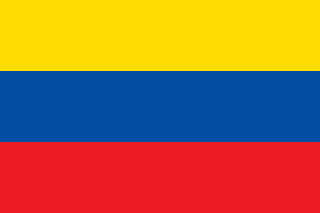
The history of the Republic of Ecuador from 1830 to 1860 begins with the collapse of the nation of Gran Colombia in 1830, followed by the assassination of Antonio José de Sucre and the death of Simón Bolívar from tuberculosis the same year. Heartbroken at the dissolution of Gran Colombia, Bolívar is quoted to have said shortly before his death, "America is ungovernable. Those who have served the revolution have plowed the sea." These words would seem prophetic during the chaotic first thirty years of Ecuador's existence.

The Battle of Tarqui, also known as the Battle of Portete de Tarqui, took place on 27 February 1829 at Tarqui, near Cuenca, today part of Ecuador. It was fought between troops from Gran Colombia, commanded by Antonio José de Sucre, and Peruvian troops under José de La Mar. Although the Colombian troops achieved victory over the Peruvian vanguard, destroying it and forcing the rest of their forces to withdraw, they suffered heavy losses in their cavalry with the Peruvian charge, which made it difficult to continue the campaign and caused the stabilization of the front.

The Battle of Guayaquil was the final and pivotal armed confrontation in a struggle for political control of Ecuador. The battle was fought on the outskirts of the city of Guayaquil, Ecuador on September 22–24, 1860, among several factions claiming control of the country in the wake of the abdication of president Francisco Robles, amidst continuous Peruvian military pressure due to the ongoing Ecuadorian–Peruvian territorial dispute. The battle brought an end to a series of skirmishes between the forces of Gabriel García Moreno's Provisional Government, backed by General Juan José Flores, and the government of General Guillermo Franco in Guayas, which was recognized by Peruvian president Ramón Castilla.
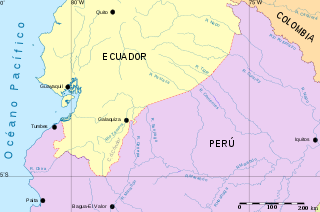
The Brasilia Presidential Act, also known as the Fujimori–Mahuad Treaty, is an international treaty signed in Brasilia by the then President of Ecuador, Jamil Mahuad and then President of Peru, Alberto Fujimori, which effectively put an end to the Ecuadorian–Peruvian territorial dispute.

The Colombian–Peruvian territorial dispute was a territorial dispute between Colombia and Peru, which, until 1916, also included Ecuador. The dispute had its origins on each country's interpretation of what Real Cedulas Spain used to precisely define its possessions in the Americas. After independence, all of Spain's former territories signed and agreed to proclaim their limits in the basis of the principle of uti possidetis juris, which regarded the Spanish borders of 1810 as the borders of the new republics. However, conflicting claims and disagreements between the newly formed countries eventually escalated to the point of armed conflicts on several occasions.
The South American territorial disputes are the territorial disputes and litigations that have developed in South America since the aftermath of the continent's wars of independence, which have shaped the current political geography of the region. These conflicts have been resolved through both military and diplomatic means. The most recent conflict in the Americas of this nature was the Cenepa War in 1995, between Ecuador and Peru.
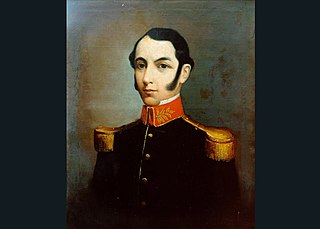
Luis Urdaneta Farías was a Venezuelan soldier and revolutionary who participated in several military campaigns of the Spanish American Wars of Independence. Initially part of the troops loyal to the Spanish Empire, he switched sides during the conflict. He participated and played a leading role in the independence of Guayaquil. He fought in several battles under the command of Marshal Antonio José de Sucre in the Southern Campaign and in the Gran Colombia–Peru War. He insurrectioned against Juan José Flores' attempted separation of the Southern District from Gran Colombia.
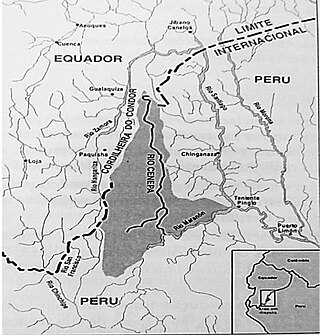
The Alto Cenepa confrontation was an armed clash that occurred in January 1978 on the de facto border between Ecuador and Peru in the Alto Cenepa area, Cordillera del Cóndor. The conflict arose from the advance of a detachment of the Ecuadorian Army into territory administered by Peru according to the Rio de Janeiro Protocol.